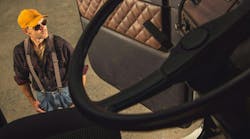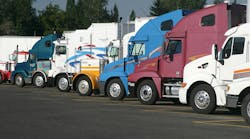Transit buses and freight-carrying trucks would seem to have little in common – except when it comes to analyzing vehicle operation behavior in terms of collision risk. Del Lisk, vp-safety services for in-cab video provider DriveCam, contends that transit buses and local delivery trucks operate on the same crowded urban roadways along similar time-sensitive stop-and-go routes.
As a result, according to Lisk, certain driver behaviors can increase the risk of collisions for both sets of vehicles, but even more so for trucks as they often are heavier than transit buses, he told Fleet Owner.
“There’s definitely a correlation between transit bus operations and local delivery fleets, as both tend to operate predominately in urban areas on city streets versus highways,” Lisk said.
DriveCam analyzed the recorded behavior of 20,000 drivers in the transit industry between June 2009 and June 2010, focusing on the largest observed variance between multi-collision and non-collision transit drivers.
While transit drivers with multiple collisions represent only 0.4% of all transit drivers in DriveCam’s study, more than 70% were consistently cited for four poor driving behaviors. Additionally, multi-collision drivers showed a significantly higher frequency across all poor driving behaviors, Lisk noted.
The behaviors with the largest observed variance between multi-collision and non-collision transit drivers per DriveCam’s numbers were:
- Following too close - 1.25 to 1.75 seconds (58% of multi-collision drivers, 33% of non-collision drivers). Additionally, 1 second or less (24% of multi-collision drivers, 10% of non-collision drivers)
- Failed to keep an “out’ (30% of multi-collision drivers, 11% of non-collision drivers)
- Not looking far enough ahead (64% of multi-collision drivers, 48% of non-collision drivers)
- Rolling stops (32% of multi-collision drivers, 19% of non-collision drivers)
“’Following too close is a major problem here because the DOT [U.S. Department of Transportation] recommends four seconds of following distance for larger vehicles,” Lisk said. “Even if no crash results from ‘following too close’ there are other consequences, as harder braking is required. That can lead to a passenger falling on a bus-- but for a truck, that can cause load shifting and freight damage.”
More wear and tear due to hard braking applies equally to buses and trucks, he added.
“Failing to keep an out” is a traffic navigation concept that recommends maintaining space not just in front of one’s vehicle but alongside as well, so buses and trucks alike have maneuvering room in case something happens.
“Space allows a truck or bus to get away from a problem, but ‘failing to keep an out’ indicates drivers in this instance get unnecessarily crowded in with other vehicles,” Lisk pointed out. “When vehicles are closer together on city streets, there’s lower margin for error.”
He also noted that “not looking far enough ahead” typically translates into looking 12 to 15 seconds of travel time ahead of a vehicle – equating roughly to a block and a half in city street terms.
“Drivers need to look that far ahead to gain reaction time to congestion, traffic lights, road construction, etc.,” Lisk said. “If they can see the problem in time, they can make changes safely and smoothly, without hard braking or emergency maneuvers.”
Finally, the “rolling stop” phenomenon is a particularly acute problem for transit buses and delivery trucks as they tend to operate on set routes. “Drivers get used to their route, get used to not fully stopping and checking an intersection because no one is ever there,” Lisk explained. “This may go on for weeks, months, even years without incident – until one day something is in the intersection.”
He noted that DriveCam’s Video Event Recorder does not analyze collision events for legal reasons. However, he said allowing for video event review helps fleets recognize those behaviors that are leading indicators of future risk, thus allowing fleet safety and risk managers to coach and train drivers to avoid costly outcomes such as hard braking, emergency maneuvers, and, ultimately collisions.




